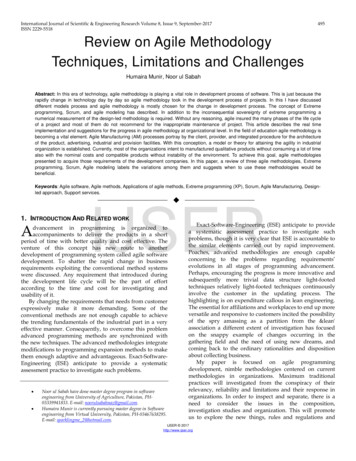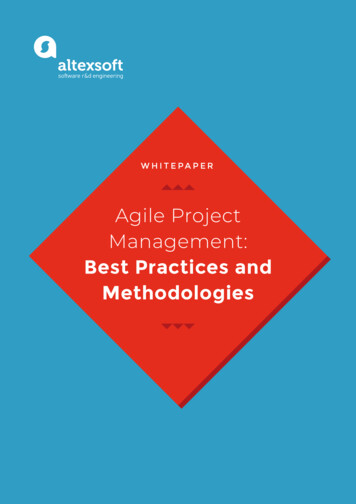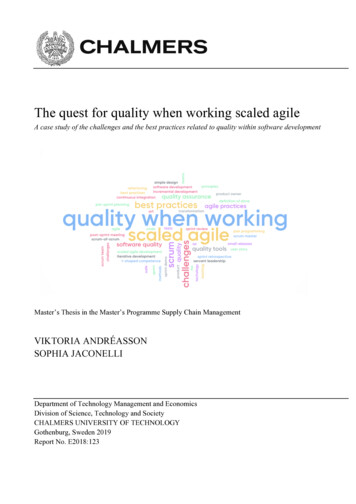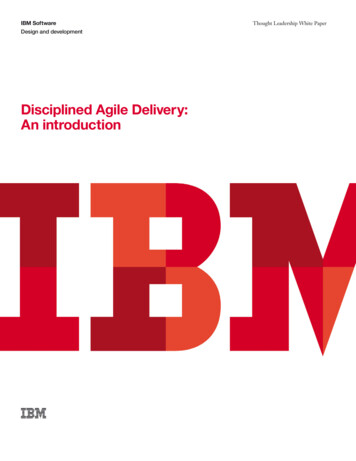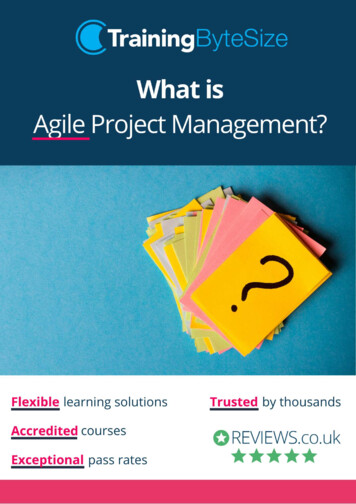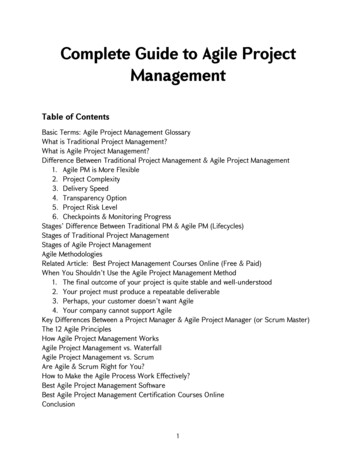
Transcription
Complete Guide to Agile ProjectManagementTable of ContentsBasic Terms: Agile Project Management GlossaryWhat is Traditional Project Management?What is Agile Project Management?Difference Between Traditional Project Management & Agile Project Management1. Agile PM is More Flexible2. Project Complexity3. Delivery Speed4. Transparency Option5. Project Risk Level6. Checkpoints & Monitoring ProgressStages’ Difference Between Traditional PM & Agile PM (Lifecycles)Stages of Traditional Project ManagementStages of Agile Project ManagementAgile MethodologiesRelated Article: Best Project Management Courses Online (Free & Paid)When You Shouldn’t Use the Agile Project Management Method1. The final outcome of your project is quite stable and well-understood2. Your project must produce a repeatable deliverable3. Perhaps, your customer doesn’t want Agile4. Your company cannot support AgileKey Differences Between a Project Manager & Agile Project Manager (or Scrum Master)The 12 Agile PrinciplesHow Agile Project Management WorksAgile Project Management vs. WaterfallAgile Project Management vs. ScrumAre Agile & Scrum Right for You?How to Make the Agile Process Work Effectively?Best Agile Project Management SoftwareBest Agile Project Management Certification Courses OnlineConclusion1
For a couple of weeks, we've been preparing this guide to agile project management.We've gathered all the required information on agile project management and how tobecome a certified project manager.Today, this kind of profession is one of the most required ones in the world.Before delving into more details of Agile Project Management (APM), let's see theglossary and the most common terms you'll be using during your APM work.Basic Terms: Agile Project Management GlossaryAgile – an iterative project management approach to manage projects in the ITsphere.Agile Development – a term used basically for iterative software developmentmethodologies such as Scrum, eXtreme Programming (XP), and others.Agile Manifesto – a brief document that includes 4 values and 12 principles forsuccessful agile software development.Backlog – prioritized work that still needs to be finished.Burndown Chart – professionals use this to monitor the progress of the project. Itshows the remained work that should still be done versus the total time left.Cadence – the time (number of days, weeks, months) in a Sprint or the team’sdevelopment cycle length.Ceremonies – meetings, often a daily planning meeting, that identify what has beendone, what is to be done, and the barriers to success.Disciplined Agile Delivery (or DAD) – process-decision guidelines providing contextspecific guidance based on your business needs trying to increase the quality of yourproduct.Daily Scrum – a daily meeting with the team on planning, monitoring, and discussingthe tasks.DevOps (or Development Operations) – bridges the gap between agile teams andoperational delivery to production.2
Dynamic Systems Development Method (or DSDM) - this is an agile project deliveryframework used in the software development processes.eXtreme Programming (XP) – another agile development methodology that's used inthe software development process. It helps to produce higher quality software aswell as a higher quality of life for the software development team members.Kanban – a visual system for managing work processes.Kanban Board – one of the key components of the Kanban methodology helping tomonitor and reveal the status, progress, and issues related to the work processvisually.Lean – a method in software development that helps teams to deliver projects faster.LeSS (large-scale Scrum) – agile development method that project managers apply tonot just small teams but also to an agile team consisting of fifteen, hundred or eventhousands of members.Rapid Application Development (RAD) – agile development method that highlights theuse of software and user feedback to meet business requirements.Requirements – in the case of Agile projects also known as "user stories" is thedocument mentioning all the capabilities you want in a planned system.Scaled Agile Framework Enterprise (or SAFe) – is another Agile methodology usedduring the software development process.Scaled Agile – is a toolbox guiding companies in scaling lean and agile practices (agilescaled up to large projects or programs).Scrum – one of the worldwide known methodologies used in software developmenthelping teams to review and see the progress of a single development phase (alsocalled Sprint).(The) Scrum of Scrums – a technique used for multiple teams working on the sameproduct/project.Scrum master – this is (hopefully) you - the person who's monitoring the wholedevelopment process and assures everyone's delivering their work on time.3
Sprint – a short development phase within a larger project. For example, it's whenteams define a short duration of a Sprint (in a large project) up to 5 days to 4 weekstimebox.Sprint retrospective – is a good opportunity for the team to review their own workand create a reshaped plan for improvements that have them discussed/implementedduring the next Sprint.Velocity – some measure of the work done the working team can handle during oneSprint.Waterfall – a structured project management approach helping softwaredevelopment teams to organize their work.What is Traditional Project Management?The traditional Project Management (meaning the waterfall approach) is a universalapproach that includes a set of unique techniques used for planning, estimating, andcontrolling activities (in sequence).In the case of traditional PM, every project follows the same life cycle. The standardlife cycle includes some stages such as feasibility, planning, designing, building,testing, production, and support.The entire project is planned beforehand (with fixed time and costs) with no changingpossibility. So once the project development starts one should be extremely careful notto make any mistakes during its implementation.What is Agile Project Management?In short, Agile is a project management methodology.The methodology includes sprints that are short development cycles focusing oncontinuous improvement in the development of a product, service, or process.Today, agile project management is rapidly developing and it's one of the top paid jobsin the world. Moreover, Agile projects are 28% more successful than traditionalprojects.4
Also, according to various sources, the salary for agile project managers varies from 66,137 to 154,063 per year.So if you're still fluctuating whether to shift your career and become an agile projectmanager, it's worth it!To delve even more into Agile PM spend some minutes and explore what the Agilemethodology is in the video below from Linkedin:https://www.youtube.com/watch?v MJR-EgHTA4EDifference Between Traditional Project Management &Agile Project Management?Many project managers and experienced developers use project management skills tohandle their projects on time.However, many of them prefer to use the Agile methodology instead of TraditionalPM because of some reason.1. Agile PM is More FlexibleIn the case of traditional project management, one should define every singleprocess right at the start of each project.It cannot deal with any big change (or especially feedbacks) requiring some change inthe process. In almost all the projects final delivery time and the costs along withbudget are fixed. So one can change it very rarely.When doing Agile project management, you do have a huge space for feedback fromthe clients' side. Here the process is very flexible.Moreover, clients follow the process and they can provide feedback at any stage of theproject. In the end, you get a better product without a headache.The reason is that the Agile PM methodology isn’t linear (compared to the TraditionalPM) and doesn't require a top-down approach. So you shouldn't suffer from lastminute changes that can disrupt the project time frame.2. Project Complexity5
Overall, people use traditional project management methodology basically for not bigand less complex projects.As I've mentioned before, it doesn't like unexpected changes. So here the Agile could beyour best option to handle big and complex projects.But why prefer Agile PM?Because complex projects include multiple interconnected phases or just one stage.And here comes Agile PM to help you finish the bigger projects.3. Delivery SpeedThe speed does matter!When it comes to finishing a project on time, anything can happen.The Agile PM ensures that your team is safely and constantly delivering good-workingproducts. This means that any client can get access to the product anytime withoutwaiting for the final working version.For example, they can wait for 6 months, 1 year, 2 years, or even more get the finalversion of the product. Agile PM makes the process much faster seeing the changes inmuch shorter intervals (very often every 2 to 4 weeks).4. Transparency OptionThe Agile PM methodology is quite transparent. The clients (or other people) can getaccess to the project's every single phase (initiation, planning, review, testing).The agile methodology allows a project's team members to view the progress from thevery start to the end.5. Project Risk LevelDuring the Agile PM, the risk of a project failing is minimal.A good project manager divides a large project into some iterations. Thus, theydecrease the risk level of failing it.6
In the case of traditional PM, you realize the real risk of the project when almosteverything is done or when you get the project finalized.Every project manager, project owner, or project financing organization wishes touse less time, effort, and money but get good final results. So this is their chance toget what they want and avoid any problems.5. Checkpoints & Monitoring ProgressThe traditional PM method advises spending much time planning the project at theanalysis and design stage of the project. In this case, the focus is on smoothing theprocesses and not the product itself.When the planning is over, the team members should follow the steps in that withminimal guidance.One assesses the effectiveness of the project when it's already completed. No regularmeetings unless the PM receives any guidelines.The Agile methodology encourages team members to meet and have checkpoints atregular intervals. When meeting every 2 or 4 weeks, it's quite easier to check all thework done, its effectiveness, and discuss any issues on the way to the finish line.If the work process requires more frequent meetings, you can use one of Agile othermethodologies - Scrum. In this case, team members or numerous teams meet on a dailybasis to discuss the work done after the last meeting, to make changes, or tackle theobstacles.To visually show you the difference between traditional PM and Agile PM, we haveresearched and provided you the best infographics on the topic.One of the best visual overall pictures I could found, you can see below (infographicfrom Kanbanize.com):7
Image Source: Kanbanize.comHere's another good infographic from Kissflow.com:Image Source: Kissflow.comAnd another infographic to fully show you the visual comparison of Agile projectmanagement and traditional project management (infographic from Knowledgehut.com):8
Image Source: Knowledgehut.comAlso, you should pay attention to the main characteristics of the two approaches.Such characteristics include but not limited to a linear or iterative process, project'sscale (small, medium or large), client's involvement in the work process, and others.The full list of characteristics you can see in this infographic below:9
10
Infographic source: Knowledgehut.comStages' Difference Between Traditional PM & Agile PM(Lifecycles)Stages of Traditional Project ManagementBasically, there are 5 project management process groups: Initiating: This is the very first stage of the Traditional PM - it should define theproject.Planning: Next, the planning phase includes developing the full roadmap for theproject's every member to follow.Executing & Monitoring: In this executing phase, you're starting the project.When having the project started, the PM creates the working team anddeliverables. Afterward, they monitor and measure project performance toensure how it's going.Closing: The completion of the project. After finishing the project, it's beingtransferred to another team who will maintain it.Stages of Agile Project ManagementIn general, there are 6 basic stages of the Agile Development Life Cycle:1.2.3.4.5.6.Scope out and prioritize projectsDiagram requirements for the initial sprintConstruction/iterationRelease the iteration into productionProduction and ongoing support for the software releaseRetirementWe'll not make it even longer and will definitely advise you to read the article fromLucidchart.com on "The stages of the Agile software development life cycle."11
Agile MethodologiesThere are a variety of Agile methodologies in the world today.We've mentioned some of the most frequently used by the Agile project managers.Those methodologies include but not limited to the following: KanbanScrumDisciplined Agile Delivery (DAD)Agile Unified Process (AUP)ScrumbanCrystalCrystal Clear methodsAdaptive Software DevelopmentFeature Driven DevelopmentAgile ModelingLean Software Development, etc.All in all, the key role of each Agile method is to avoid any obstacles (by adapting tochange, like Chameleons) and deliver working software (or a good-working finalproduct/project) as quickly as possible.However, even though the goal of each mentioned methodologies is the same, eachteam’s process flow may vary depending on the project's or product's specifications.Related Article: Best Project Management Courses Online (Free & Paid)12
When You Shouldn't Use the Agile Project ManagementMethodAlthough the Agile has huge advantages and benefits, it's not considered for everyproject/organization.But how to identify when the Agile PM isn't the best methodology to use?To make your job easier, I have gathered 4 cases when the Agile development modelisn’t the best option for your projects.1. The final outcome of your project is quite stable and well-understoodAs you may already know, people use Agile to reduce the cost of the occurred changeand uncertainty.In contrast, if there are very little uncertainty and a low possibility of change, thenyou can use another methodology rather than Agile.For instance, if you work in a patent industry with heavy regulations you don’t neediterative planning and multiple drafts.2. Your project must produce a repeatable deliverableFrom the very beginning to the end, Agile's core function is to create a uniqueproduct, service, or result.”But imagine a situation when a customer asks you to construct 10 identical houses. Inthis case, your final product/result will be 10 unique houses and not 5 identical ones.So one of the disadvantages of Agile is that it's not considered for reproducibility.3. Perhaps, your customer doesn’t want AgileAn Agile project requires being constantly in touch with your end customer.But there are some cases when customers don't have the time, will, or ability and don'tdesire to dedicate to a project. So if the project contains a low value or low risk, theymay prefer a more traditional methodology instead of using the Agile one.13
4. Your company cannot support AgileIf your company, product, or project team isn’t ready for Agile, trying to adopt it cancontain some risk to your project. So be sure they have all the resources to cross thefinish line.Key Differences Between a Project Manager & AgileProject Manager (or Scrum Master)The Project Manager manages a project on a day-to-day basis and is the only personwith monitoring on the changes of the project.Also, if there are no managers within the company they implement Project Supportand Team Management.On the other hand, the main responsibility of the Scrum Master is to monitor andmanage the Scrum Framework (according to the Scrum Guide).14
For the detailed information, you can read this article from Medium on Scrum Mastervs Project Manager - An overview of the differences.The 12 Agile PrinciplesOverall, Manifesto for Agile Software Development highlights 12 Agile principles forall the projects to follow.We'll keep short and just mention the 12 Agile Principles:1. The top priority is customer satisfaction: one should achieve it via fast andcontinuous delivery.2. Project managers can implement changes at any stage of the process (forcustomer's competitive advantage).3. Project managers deliver the product or service with a higher frequency.4. Both stakeholders and developers (or their team members) cooperate witheach other closely on a daily basis (not to miss any issues).5. It's more efficient to build projects around motivated people. The role of PMshould be to provide all the necessary environment and support they need to dothe job in the best possible way.6. All in all, face-to-face meetings stay the most effective way for project success.7. Working software is the primary measure of progress - This means thatdelivering a good-working and functional software to the client is the mostimportant factor that measures progress.8. Constant development is being done via agile processes. Next, the developmentteams and stakeholders are having the opportunity to maintain an ongoing pace.9. Agile PMs should make the Agility stronger by continuously focusing ontechnical excellence as well as proper design.10. Simplicity (the strategy of revealing and maximizing the amount of missed work)is an essential element.11. It's all about self-organizing teams: they develop the best practices along witharchitectures and designs meeting program requirements.12. Regular intervals help teams to work and become more effectively (along withfine-tuning behaviors).15
How Agile Project Management WorksFirst and foremost, Agile Project Management guides the teams to continuouslyevaluate time and cost throughout the whole work process.To make the process simpler, Agile PMs use velocity, burndown, and burnup charts toassess the ongoing work.In contrast, Traditional PMs use Gantt charts and project milestones to track andmeasure the implementation of their work.As mentioned before, Scrum is a framework for Agile PMs including iterations ofsprints.Generally, there are 4 ceremonies that bring detailed structure to each sprint.Sprint PlanningSprint DemoDaily StandupRetrospectiveTeam PlanningMeeting: thisdetermines whattasks to implementin the comingsprint.SharingMeeting: herethe team showswhat they'vealready done inthat sprint.Also known as a"Stand-up", a 15minute smallmeeting to gettogether andcoordinate theteam's activities.A review of what the softwaredevelopment team hasimplemented at the end of aproject/process to discusssuccess, failure, or possibleimprovements for future work.To fully reveal how Agile PM works, we've found this video below (fromProjectManager.com) that will help you visually get the full picture:https://www.youtube.com/watch?v DvBKevrItccAgile Project Management vs. WaterfallWhy in many ways the Agile PM is a better option than the Waterfall methodology?The thing is that the Waterfall Model follows strict rules including a strict sequentialapproach to projects. The process starts with gathering all the requirements needed forthe project before the work begins.16
That's the reason why in 2001 17 software developers published the Agile Manifestowhere they outlined 12 principles of Agile Software Development (mentioned a littleabove).In the Agile Manifesto, they made it possible to make changes in any project/programdevelopment phase.Overall, the waterfall method has such a picture:Image Source: Altexsoft.comOn the other hand, Agile methodology has another picture:17
Image Source: Altexsoft.comYou can explore the full differences in this table below from Guru99.com:AgileWaterfallIt separates the project developmentlifecycle into sprints.The software development process is dividedinto distinct phases.It follows an incremental approachThe waterfall methodology is a sequentialdesign process.Agile methodology is famous for itsflexibility.The waterfall is a structured softwaredevelopment methodology so most times itcan be quite rigid.Agile can be considered as a collection of Software development will be completed asmany different projects.one single project.Agile is quite a flexible method that allowsThere is no scope of changing thechanges to be made in the projectrequirements once the project developmentdevelopment requirements even if thestarts.initial planning has been completed.Agile methodology, follow an iterativedevelopment approach because of thisplanning, development, prototyping, andother software development phases thatmay appear more than once.All the project development phases likedesigning, development, testing, etc. arecompleted once in the Waterfall model.18
The test plan is reviewed after eachsprint.The test plan is rarely discussed during thetest phase.Agile development is a process in whichThe method is ideal for projects which havethe requirements are expected to change definite requirements and changes not at alland evolve.expected.In Agile methodology, testing isperformed concurrently with softwaredevelopment.In this methodology, the "Testing" phasecomes after the "Build" phase.Agile introduces a product mindset whereThis model shows a project mindset andthe software product satisfies the needs ofplaces its focus completely on accomplishingits end customers and changes itself asthe project.per the customer's demands.The agile methodology worksexceptionally well with Time & Materialsor non-fixed funding. It may increasestress in fixed-price scenarios.Reduces risk in the firm-fixed-pricecontracts by getting risk agreement at thebeginning of the process.Prefers small but dedicated teams with ahigh degree of coordination andsynchronization.Team coordination/synchronization is verylimited.Products owner with team preparesBusiness analysis prepares requirementsrequirements just about every day duringbefore the beginning of the project.a project.The test team can take part in therequirements change without problems.It is difficult for the test to initiate anychange in requirements.Description of project details can beDetail description needs to implement thealtered anytime during the SDLC process. waterfall software development approach.The Agile Team members areinterchangeable, as a result, they workfaster. There is also no need for projectmanagers because the projects aremanaged by the entire team.In the waterfall method, the process isalways straightforward so, the projectmanager plays an essential role during everystage of SDLC.19
Agile Project Management vs. ScrumThings can be a bit confusing as you'll see and use the “Scrum” and “Agile” thousandsof times when you first enter the PM world.However, they are not the same!Here's an example of a detailed Scrum introduction:https://www.youtube.com/watch?v K7YMEFjh724Scrum is only a framework that PMs use to implement Agile development.On the other hand, Agile is a whole process for getting the desired results. And for thefinal results, the Agile is using numerous simple methodologies including Scrum.Generally, there are 3 scrum team roles in the PM industry:1. Product Owner who manages the product vision and make sure a good ROI(return on investment).2. Scrum Master - this is the person who manages the scrum process.3. Self-Managing Team - the project/product team members who implement thedaily tasks required for each sprint.As for the scrum meetings, there are 5 types of scrum meetings:1. Sprint Planning Meeting - this type of meeting is held at the beginning of eachsprint.2. Daily Scrum & Sprint Execution Meeting - daily small meetings (for example,10-15 minutes).3. Sprint Review Meeting - held after the last sprint meeting to provide a workingproduct demonstration to the product owner.4. Sprint Retrospective Meeting – held at the end of a sprint. The purpose of thistype of meeting is to evaluate the working process and identify if there is space forimprovement.5. Backlog Refinement Meeting – held before the next Sprint Planning Meeting toensure the backlog is ready for the next sprint.After the current sprint, the next one begins. The meetings help scrum teams to makedecisions by analyzing the current situation.20
Are Agile & Scrum Right for You?Generally, the Agile method is more relevant for the cases where customers and projectstakeholders should provide input, functional portions, or quick changes.Why consider it?Because flexibility is at the core of effective collaboration.When you have projects with uncertain requirements, technological projects, orespecially projects where most probably would be numerous changes, Scrum is right foryou.In Scrum, a set of defined processes can help you manage even the most complexprojects (we've talked about the benefits of using Agile a little above).If your project requires knowledge generation and getting new products with smallself-organized teams, Scrum is the best way to get things done faster.How to Make the Agile Process Work Effectively?When working with the Agile methodology, not everything can go smoothly. You shouldhave some strategy to make things done in a more efficient way.Here are some activities that can help in adoption the Agile workflow: Daily Meetings - One of the top tactics Agile PMs use today to keep eachiteration moving forward.Live Demonstrations - Deliver live demonstrations to the team and show eachiteration’s final product progress.Share Feedback - Receive or ask feedback from customers and stakeholders.Next, share the received feedback with the working team before the nextiteration.Remain Agile - Feedback is the key. Make changes to your process based onfeedback to ensure each iteration improves the lastNumerous project managers use this strategy to make the Agile process work even moreeffectively. So why not try it?Best Agile Project Management Software21
Companies using numerous software programs to handle project management tasks.Here are some of the Agile software solutions for you: Atlassian Jira: This is probably the most famous software tool use by Agileproject managers. It supports Scrum, Kanban, and mixed methodologies aswell.VersionOne: This PM solution is ready to support the Scaled Agile Frameworkat all levels.Trello: Trello allows its users to work more collaboratively and get more done.Trello is an easy PM online tool to help you keep tracking every single task in oneplace.Monday.com: This is a project management tool that powers teams to implementprocesses, workflows, and projects in one digital workspace.Nifty: The PM tool is a collaboration hub providing people the opportunity tomanage tasks, timelines, and workloads clear to your team members andclients.Also, it's worth to mention that choosing an Agile project management tool depends onyour organization's accepted policy, budget, and practice.For example, if they use Jira for a long time, you will have to accept that and move onwith that option even if you like another tool more.For more tools, you can explore these Agile tools for software teams.22
Best Agile Project Management Certification CoursesOnlineThe Agile industry is rapidly growing along with the demand for Scrum Masters orAgile professionals.Here's a good article on "What is a Scrum Master" that includes the definition of ascrum master, their responsibilities, and even more.In addition, providing you with five of the best agile-focused certifications to get youcertified and smash: Agile Certification InstituteScrum AllianceStrategyex Certificate (Associate or Master’s) in agileInternational Consortium for Agile (ICAgile)Scaled Agile AcademyConclusionA shift in career is a huge responsibility and opportunity at the same time.One should meticulously explore every detail and excel in this guide to agile projectmanagement to be ready for the issues and trials of becoming a good Agile ProjectManager.Hopefully, the provided information will lead you through the tough process of startinga new career in the Agile world.I will finish my article with the words of Paulo Coelho:“One day you will wake up and there won't be any more time to do the things you'vealways wanted.Do it now!”23
Paulo CoelhoGood Luck! 24
Agile - an iterative project management approach to manage projects in the IT-sphere. Agile Development - a term used basically for iterative software development methodologies such as Scrum, eXtreme Programming (XP), and others. Agile Manifesto - a brief document that includes 4 values and 12 principles for successful agile software .


